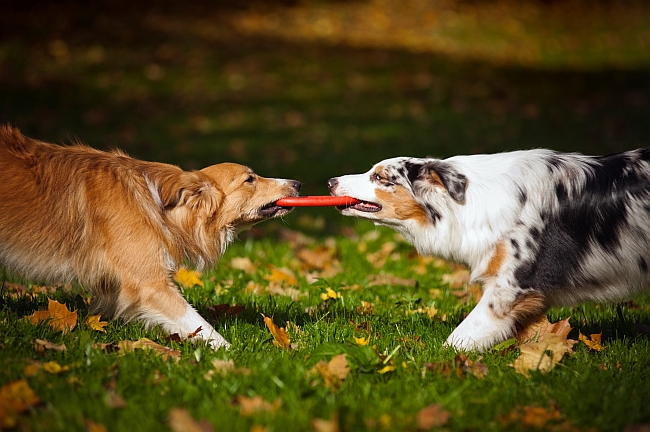
It is normal for kids to bicker and fight from time to time, but when two adult dogs cause more drama than the humans, something has to be done. If your pooches are constantly at each other’s throats during the daily walk, or fiercely vying for attention while playing fetch; it is time to recalibrate how to fix the situation. The good news is, same-house dog rivalries are not insurmountable, and can be overcome with a few helpful adjustments. So take a break from the madness and let the brainstorming begin!
Considerations
- Triggers: Try to figure out what sets the dogs off. When do they begin their barking battles? Does one dog’s anxiety or nervous behavior set the other dog into a tizzy? Is one dog being particularly persnickety, because he is uncomfortable or in pain? Perhaps he is allergic to the brand of food, and the digestive discomfort is making him easily agitated.
- Stressors and Solutions: Before you determine to solve the problem, you must first consider potential root causes for the stress issue.
- Exercising/Stimulation: Is one of the dogs tense because of from a lack of exercise? Maybe they are under-exercised or bored, and are lashing out at each other in agitation or need for something to do. Consider enrolling each dog in a training camp or an outdoor activity of some sort on a weekly basis. Such an experience will give the dogs a chance to stimulate their minds and will distract them from fighting, barking and wrestling with each other.
- Joint outings: While walking your dog, be sure to place them side by side. This will help the dogs focus on a common goal of moving forward. They will be pleasantly diverted to taking in the scents and sights around them, instead of picking a fight with each other.
- Diet: After exercise, determine whether or not your dogs are being properly nourished, with well-balanced vitamins and supplements. Help your canine companions by giving them what they need to thrive.
- Health Concerns: Check your dogs for bumps, bruises, cuts, sore paws, or any area where they might be in pain. One dog might act defensively if the other pup has accidently hurt a wound or ailing area. If one dog is exhibiting unusual behaviors that seem to be increasing stress in the home, go a vet to identify and treat the issue.
- Spatial boundaries: Another consideration is the realm of space within the home. Is some of the strain caused because there is no individual space for each pooch? Do the dogs share a bed, toys and food bowls all the time? Find a way to avoid these stressors by creating some boundaries and “safe spaces” for each individual dog. Make sure each one has their own sleeping pad, retreat space and food bowl. Give them individual toys, and watch like a hawk to make sure one isn’t stealing toys from the other. Be a good “parent” by helping correct the dog’s behaviors when needed.
- Positive Association: Clearly the puppy pals got started off on the wrong foot. Maybe they weren’t integrated gradually enough to each other; maybe one felt abandoned and competitive; or realized that only negative behavior would get your attention when the new dog came on the scene. Whatever the case may be, it might be time to start positively associating the dogs to each other. Some owners have attempted this by bringing the original dog to an empty room, then having someone else bring in the second dog on a leash. When the other dog enters, the owner starts feeding the first dog some new treats, and praising him. The second dog is taken out of the room, and the owner stops giving the dog treats. After a few moments, the second dog comes back in, and (when the first dog registers the other dog’s presence) he gets more treats. This cycle should continue every day, with the length of time growing, each time the second dog and treats enter. Pause and let the dogs look at each other; feeding them a treat whenever they do. Other dog owners bring the second dog closer to the first dog with every entrance, until the dogs can stand comfortably near to each other without agitation. Though this method takes time to achieve, it is one way to help animals reverse negative associations about the presence of the other dog.
- Human involvement: You are still the pack leader –so don’t let your dogs run the show. If Fido is chewing on the toy first, and Rover comes over and takes it away, it’s time to intervene. Tell Rover “no” and “drop” then give him a treat, and hand the toy back to Fido. Help Rover find another toy/diversion to distract him away from bothering Fido. If they are fighting with each other for some reason, or intensity is escalating, it is your responsibility to break it up. Without exerting useless force or shouting, simply pull the most aggressive dog up and away from the conflict zone. Command “no!” and then offer a distraction.
The way your dogs interact is a reflection on how you lead in the home. If your job or family life is too demanding to devote the time needed to train your pets, perhaps you should reconsider getting that second dog. Exert your authority as the dominant pack leader, and help your dogs learn the appropriate protocol of inter-canine behavior in your home.

